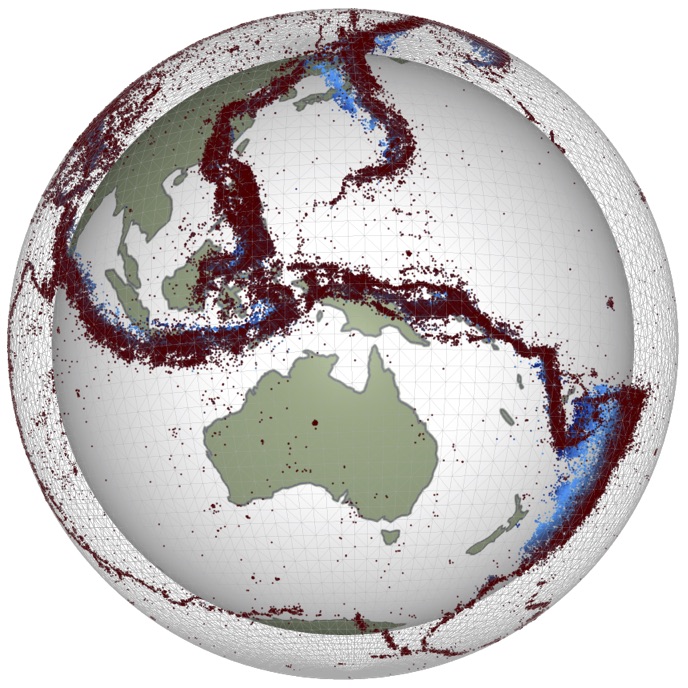Rayleigh Taylor - swarm materials#
We introduce the notion of an IndexSwarmVariable which automatically generates masks for a swarm
variable that consists of discrete level values (integers).
For a variable \(M\), the mask variables are \(\left\{ M^0, M^1, M^2 \ldots M^{N-1} \right\}\) where \(N\) is the number of indices (e.g. material types) on the variable. This value must be defined in advance.
The masks are orthogonal in the sense that \(M^i * M^j = 0\) if \(i \ne j\), and they are complete in the sense that \(\sum_i M^i = 1\) at all points.
The masks are implemented as continuous mesh variables (the user can specify the interpolation order) and so they are also differentiable (once).
# to fix trame issue
import nest_asyncio
nest_asyncio.apply()
import petsc4py
from petsc4py import PETSc
import underworld3 as uw
from underworld3.systems import Stokes
from underworld3 import function
import numpy as np
import sympy
render = True
cell_size = uw.options.getReal("mesh_cell_size", default=1.0 / 32)
particle_fill = uw.options.getInt("particle_fill", default=7)
viscosity_ratio = uw.options.getReal("rt_viscosity_ratio", default=1.0)
lightIndex = 0
denseIndex = 1
boxLength = 0.9142
boxHeight = 1.0
viscosityRatio = viscosity_ratio
amplitude = 0.02
offset = 0.2
model_end_time = 300.0
# material perturbation from van Keken et al. 1997
wavelength = 2.0 * boxLength
k = 2.0 * np.pi / wavelength
meshbox = uw.meshing.UnstructuredSimplexBox(
minCoords=(0.0, 0.0),
maxCoords=(boxLength, boxHeight),
cellSize=cell_size,
regular=False,
qdegree=2,
)
import sympy
# Some useful coordinate stuff
x, y = meshbox.CoordinateSystem.X
v_soln = uw.discretisation.MeshVariable(r"U", meshbox, meshbox.dim, degree=2)
p_soln = uw.discretisation.MeshVariable(r"P", meshbox, 1, degree=1)
m_cont = uw.discretisation.MeshVariable(r"M_c", meshbox, 1, degree=1, continuous=True)
swarm = uw.swarm.Swarm(mesh=meshbox)
material = uw.swarm.IndexSwarmVariable(
r"M", swarm, indices=2, proxy_degree=1, proxy_continuous=False
)
swarm.populate(fill_param=particle_fill)
with swarm.access(material):
material.data[...] = 0
with swarm.access(material):
perturbation = offset + amplitude * np.cos(
k * swarm.particle_coordinates.data[:, 0]
)
material.data[:, 0] = np.where(
perturbation > swarm.particle_coordinates.data[:, 1], lightIndex, denseIndex
)
material.sym
# print(f"Memory usage = {python_process.memory_info().rss//1000000} Mb", flush=True)
X = meshbox.CoordinateSystem.X
mat_density = np.array([0, 1]) # lightIndex, denseIndex
density = mat_density[0] * material.sym[0] + mat_density[1] * material.sym[1]
mat_viscosity = np.array([viscosityRatio, 1])
viscosity = mat_viscosity[0] * material.sym[0] + mat_viscosity[1] * material.sym[1]
# Create Stokes object
stokes = uw.systems.Stokes(
meshbox, velocityField=v_soln, pressureField=p_soln, solver_name="stokes"
)
# Set some things
import sympy
from sympy import Piecewise
stokes.constitutive_model = uw.constitutive_models.ViscousFlowModel
stokes.constitutive_model.Parameters.viscosity = viscosity
stokes.bodyforce = sympy.Matrix([0, -density])
stokes.saddle_preconditioner = 1.0 / viscosity
# free slip.
# note with petsc we always need to provide a vector of correct cardinality.
stokes.add_dirichlet_bc((sympy.oo,0.0), "Bottom")
stokes.add_dirichlet_bc((sympy.oo, 0.0), "Top")
stokes.add_dirichlet_bc((0.0,sympy.oo), "Left")
stokes.add_dirichlet_bc((0.0,sympy.oo), "Right")
stokes.rtol = 1.0e-3 # rough solution is all that's needed
print("Stokes setup", flush=True)
m_solver = uw.systems.Projection(meshbox, m_cont)
m_solver.uw_function = material.sym[1]
m_solver.smoothing = 1.0e-3
m_solver.solve()
print("Solve projection ... done", flush=True)
# stokes._setup_terms()
print("Stokes terms ... done", flush=True)
stokes.solve(zero_init_guess=True)
# check the solution
if uw.mpi.size == 1 and render:
import pyvista as pv
import underworld3.visualisation as vis
pvmesh = vis.mesh_to_pv_mesh(meshbox)
pvmesh.point_data["rho"] = vis.scalar_fn_to_pv_points(pvmesh, density)
pvmesh.point_data["visc"] = vis.scalar_fn_to_pv_points(pvmesh, sympy.log(viscosity))
pvmesh.point_data["M"] = vis.scalar_fn_to_pv_points(pvmesh, m_cont.sym)
pvmesh.point_data["V"] = vis.vector_fn_to_pv_points(pvmesh, v_soln.sym)
# point sources at cell centres
cpoints = np.zeros((meshbox._centroids[::4].shape[0], 3))
cpoints[:, 0] = meshbox._centroids[::4, 0]
cpoints[:, 1] = meshbox._centroids[::4, 1]
cpoint_cloud = pv.PolyData(cpoints)
pvstream = pvmesh.streamlines_from_source(
cpoint_cloud,
vectors="V",
integrator_type=45,
integration_direction="forward",
compute_vorticity=False,
max_steps=25,
surface_streamlines=True,
)
spoints = vis.swarm_to_pv_cloud(swarm)
spoint_cloud = pv.PolyData(spoints)
with swarm.access():
spoint_cloud.point_data["M"] = material.data[...]
pl = pv.Plotter(window_size=(1000, 750))
pl.add_mesh(pvstream, opacity=1.0)
pl.add_mesh(
pvmesh,
cmap="Blues_r",
edge_color="Gray",
show_edges=True,
scalars="M",
opacity=0.75,
)
pl.add_points(
spoint_cloud,
cmap="Reds_r",
scalars="M",
render_points_as_spheres=True,
point_size=3,
opacity=0.5,
)
# pl.add_points(pdata)
pl.show(cpos="xy")
def plot_mesh(filename):
if uw.mpi.size == 1:
import pyvista as pv
import underworld3.visualisation as vis
pvmesh = vis.mesh_to_pv_mesh(meshbox)
pvmesh.point_data["rho"] = vis.scalar_fn_to_pv_points(pvmesh, density)
pvmesh.point_data["visc"] = vis.scalar_fn_to_pv_points(pvmesh, sympy.log(viscosity))
pvmesh.point_data["M"] = vis.scalar_fn_to_pv_points(pvmesh, m_cont.sym)
pvmesh.point_data["V"] = vis.vector_fn_to_pv_points(pvmesh, v_soln.sym)
# point sources at cell centres
subsample = 3
cpoints = np.zeros((meshbox._centroids[::subsample].shape[0], 3))
cpoints[:, 0] = meshbox._centroids[::subsample, 0]
cpoints[:, 1] = meshbox._centroids[::subsample, 1]
cpoint_cloud = pv.PolyData(cpoints)
pvstream = pvmesh.streamlines_from_source(
cpoint_cloud,
vectors="V",
integrator_type=45,
integration_direction="forward",
compute_vorticity=False,
max_steps=25,
surface_streamlines=True,
)
spoints = vis.swarm_to_pv_cloud(swarm)
spoint_cloud = pv.PolyData(spoints)
with swarm.access():
spoint_cloud.point_data["M"] = material.data[...]
pl.clear()
# pl.add_mesh(pvmesh, "Gray", "wireframe")
# pl.add_arrows(arrow_loc, velocity_field, mag=0.2/vmag, opacity=0.5)
pl.add_mesh(pvstream, opacity=1)
pl.add_mesh(
pvmesh,
cmap="Blues_r",
edge_color="Gray",
show_edges=True,
scalars="M",
opacity=0.75,
)
pl.add_points(
spoint_cloud,
cmap="Reds_r",
scalars="M",
render_points_as_spheres=True,
point_size=3,
opacity=0.3,
)
pl.remove_scalar_bar("M")
pl.remove_scalar_bar("V")
# pl.remove_scalar_bar("rho")
pl.screenshot(
filename="{}.png".format(filename),
window_size=(1250, 1250),
return_img=False,
)
return
t_step = 0
!mkdir output
# Update in time
expt_name = "swarm_rt"
for step in range(0, 2): #250
stokes.solve(zero_init_guess=False)
m_solver.solve(zero_init_guess=False)
delta_t = min(10.0, stokes.estimate_dt())
# update swarm / swarm variables
if uw.mpi.rank == 0:
print("Timestep {}, dt {}".format(t_step, delta_t))
# advect swarm
swarm.advection(v_soln.sym, delta_t)
if t_step % 5 == 0:
plot_mesh(filename="{}_step_{}".format(expt_name, t_step))
# "Checkpoints"
savefile = f"swarm_rt_xy"
meshbox.write_timestep(
expt_name,
meshUpdates=True,
meshVars=[p_soln, v_soln, m_cont],
outputPath="output",
index=t_step,
)
t_step += 1

